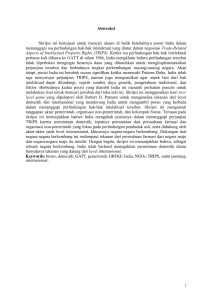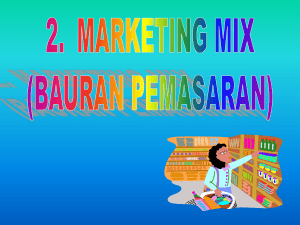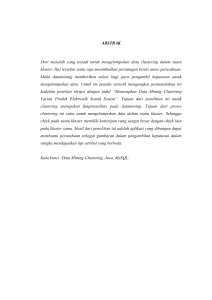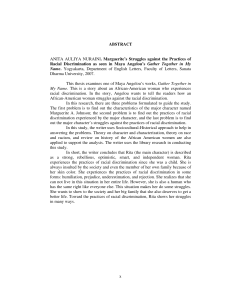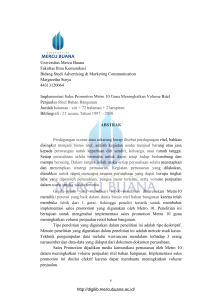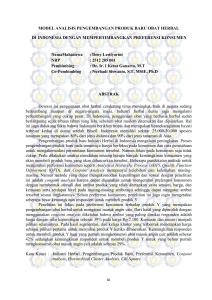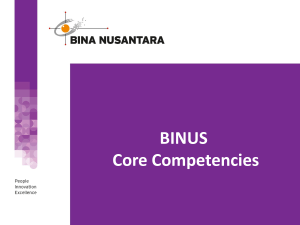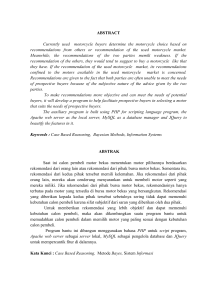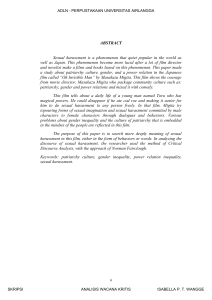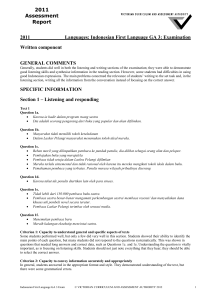STUDY ANALYSIS OF INDONESIAN CONSUMER`S BEHAVIOR IN
advertisement
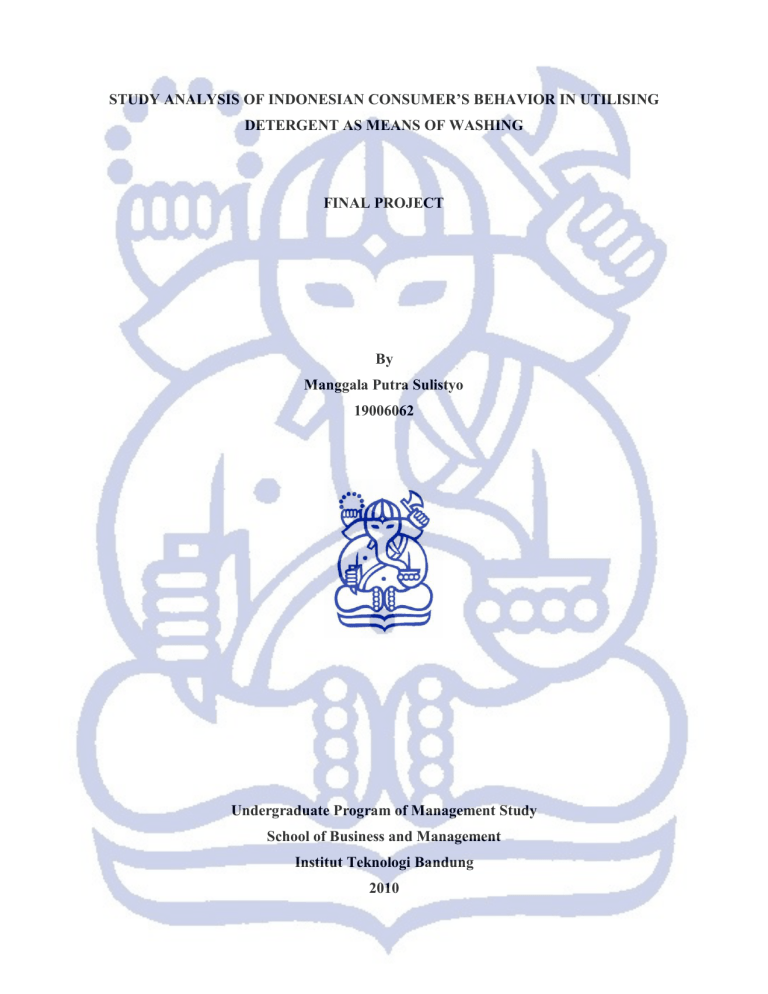
STUDY ANALYSIS OF INDONESIAN CONSUMER’S BEHAVIOR IN UTILISING DETERGENT AS MEANS OF WASHING FINAL PROJECT By Manggala Putra Sulistyo 19006062 Undergraduate Program of Management Study School of Business and Management Institut Teknologi Bandung 2010 STUDY ANALYSIS OF INDONESIAN CONSUMER’S BEHAVIOR IN UTILISING DETERGENT AS MEANS OF WASHING By MANGGALA PUTRA SULISTYO ID No: 19006062 A Final Project in Partial Fulfillment of the Requirement for the Degree of Bachelor of Management Undergraduate Program of Management Study School of Business and Management Institut Teknologi Bandung March 18th, 2010 Approved By ___________________________ DRS. Herry Hudrasyah, MA. ABSTRACT Indonesian watery system is experiencing increasing in domestic pollution level for the last decades. There are more than 60 of total 470 watersheds that placed all around Indonesian is in critical condition. Majority of the cause are domestic waste such as laundry and other cleaning activity waste. From those numbers, Java region is become the major contributor for 26 watersheds have been critically damaged. Further, we could know that is in Jakarta for parameters detergent (MBA), the percentage of wells that exceed the quality standards in Jakarta by 29% in June 2004 and increased to 46% on the month of October 2004; and still growing. The research used exploratory research which consists of literature study, ethnographic approach, focus group discussion and experts in-depth interview. This research has been designed to see relationship between the cause and the goal from behavior of consumers in using detergent and explore the idea to improve those values from the marketing side. For further, this research presents a set of marketing approach in developing the analyzed solution for increasing consumer’s knowledge level for detergent utility in order to decrease, or avoid, environmental effect of detergent. The qualitative analysis show some key variables that affect the behavior of detergent users in Indonesia. They are product-based experience, knowledge of use, environment awareness, needs, and communication of each parties. The research recommends to the stakeholders of this industry, especially producers, government, and any related parties, to: (1) implemented educational marketing method which could develop the awareness and perception of consumers for environmental based information that related to the products; (2) redesign the cycle of product to develop further use of its after-use waste and developing its affinity to the consumers; (3) Developing communication based in green marketing concept with each related parties to develop line of information for consumers; (4) to develop specification within law and regulatory system to communicate the forbade or limitation of environmental impact of utilitize detergent product in the society. Keywords: consumer behavior, ethnographic, field note, detergent, waste, green marketing. i ABSTRAK Sistem pengairan domestik Indonesia mengalami peningkatan dalam tingkat polusinya pada dekade terakhir ini. Terdapat lebih dari 60 buah Daerah Aliran Sungai (DAS) dari 470 total DAS di seluruh Indonesia kini dalam keadaan kritis. Sebagian besar penyebabnya adalah limbah domestik seperti limbah mencuci dan limbah akibat aktifitas mencuci lainnya. Dari angka-angka tersebut, wilayah Jawa menjadi kontributor terbesar yaitu sebanyak 26 DAS telah tercemar secara kritis. Lebih lanjut lagi, kita sudah mengetahui bahwa di Jakarta untuk tingkat detergent (MBA), persentase dari sumur yang telah melewati standar kualitas di telah mencapai 29% pada bulan Juni 2004 dan meningkat menjadi 46% pada bulan Oktober 2004; angka ini masih terus meningkat. Penelitian ini menggunakan metode exploratory research yang terdiri dari studi literatur, pendekatan ethnographic, focus group discussion, dan wawancara mendalam kepada para ahli. Penelitian ini telah dirancang untuk melihat hubungan antara sebab dan akibat dalam tingkah laku konsumen dalam penggunaan deterjen dan menggali ide untuk lebih mengembangkan nila-nilai tersebut dari sisi pasar. Lebih jauh, penelitian ini mempersembahkan serangkaian pendekatan pasar dalam mengembangkan solusi yang telah dianalisa untuk meningkatkan tingkat infomrasi konsumen dalam penggunaan deterjen, untuk mengurangi—atau mencegah—efek samping deterjen pada lingkungan. Analisa data menunjukkan beberapa variabel kunci yang mempengaruhi tingkat perilaku dari pengguna deterjen di Indonesia. Variabel-variabel tersebut adalah pengalaman terhadap produk, pengetahuan dalam penggunaan produk, kesadaran terhadap lingkungan, kebutuhan, dan komunikasi terhadap berbagai pihak. Penelitian ini merekomendasikan kepada pihak-pihak terkait di industri ini, khusunya produsen, pemerintah, dan setiap pihak-pihak yang terkait, untuk: (1) menerapkan metode pemasaran yang mendidik sehingga dapat meningkatkan pemahaman dan persepsi dari pengguna produk untuk informasi tentang lingkungan yang terkait dengan produk itu sendiri, (2) mendesain ulang siklus produk sehingga dapat digunakan kembali setelah pemakaian dan penerapannya pada konsumen, (3) mengembangkan komunikasi berbasis konsep green marketing dengan pihak-pihak yang terkait untuk mengembangkan jalur informasi kepada konsumen; (4) mengadakan spesifikasi dalam perundang-undangan dan sistem peraturan untuk mengkomunikasikan pelarangan atau pembatasan dari dampak lingkungan yang dihasilkan dari penggunaan produk deterjen dalam masyarakat. Kata kunci: perilaku konsumen, ethnographic, catatan lapangan, deterjen, limbah, green marketing. i FOREWORD Praise Allah the Almighty for His blessings in this final project. This project couldn’t be completed if Allah didn’t give me strengths for doing this research. I’m glad to offer my greatest gratitude for them who have supported me and my final project: 1. DRS. Herry Hudrasyah, MA for all his guidance, assistance, knowledge, thought, idea, kindness, patience, and time in supervising my research. It’s really nice to be supervised by you, Sir. 2. My beloved Sulistyo family, Dipl.Ing. Tony Sulistyo (Papa), Dr. Anita Linda Wijaya Sp.RM (Mama), Dr. Rigina Nilandrani (Gina), and my twin partner Mahardhika Putra Sulistyo (Dhika), for the unlimited supports, love, and prayers that always accompany me every moment and forever. Also my Sarbini and Ramadanus family for their unaccountable supports. 3. All SBM Family: Lecturers Tutors Administration Staffs (Mrs. Ikum, Mr. Yayat, and Mr. Iwan) Library Staffs All SBM ’09 Students 4. Dr. Ir. Katharina Oginawati M.S. of Teknik Lingkungan ITB for her help in an enligthment interview that provide resourceful data. Also to her research which give this research a new perspective in environmental based technology. 5. The amusing “Geng Maret”: Aditya Pratama, Adityawarman Dwi Putra, Narendro Anindyo, Agga Diguci, Alessandra Usman, Etgar Equator, Louis Philip, Hasfi Sihite, Pandji Alfi, Anggara Pradana, Tahta Prawiratama, Nina Shanti which provide amusement time within our last minute in SBM-ITB. Also writer’s neighbor in Cisitu Lama IX no.21: Muhammad Robby, Ginanjar Mahar, Jasper Marbun, and others for their 3 years companion. v 6. Meidiana Adhika for her lovable direct and indirect support from the distances. It is nice to have a company in doing this research and for its chat that makes me awake more than the coffee effect. Also, for your resourceful knowledge in law and regulations, it is more than enough in fact. Thank you. 7. Author’s long-time neighbors in Tamansari Persada Raya, which give various kind of support in completing this research. Their ideas and aspiration leading to the finish line of this research. 8. And for others that I couldn’t mention one by one. Finally, the writer realizes that it is not impossible that this final paper still have mistakes in the technical aspects or in the way the it’ll be serves as final paper. Therefore, author is welcoming for all comments, supportive-critical statement, and suggestion from the readers. Bandung, March 2010 Manggala Putra Sulistyo vi LIST OF CONTENTS ABSTRACT............................................................................................................................................. i FOREWORD .......................................................................................................................................... v LIST OF CONTENTS ........................................................................................................................... vii LIST OF FIGURES ................................................................................................................................ ix LIST OF TABLES ................................................................................................................................. xi LIST OF IMAGES ............................................................................................................................... xiii LIST OF APPENDIXES ...................................................................................................................... xiv CHAPTER 1 INTRODUCTION ............................................................................................................. 1 1.1. Research Background .................................................................................................................... 1 1.2. Problem Statement......................................................................................................................... 3 1.3. Research Questions ....................................................................................................................... 3 1.4. Objectives ..................................................................................................................................... 3 1.5. Research Limitation ....................................................................................................................... 4 1.6. Research Methodology .................................................................................................................. 4 1.7. Writing Structure ........................................................................................................................... 6 CHAPTER 2 THEORETICAL FOUNDATION ...................................................................................... 7 2.1. Consumer Behavior ....................................................................................................................... 7 2.1.1. Perception .............................................................................................................................. 7 2.1.2. Purchase Decision .................................................................................................................. 8 2.1.3. Brand Loyalty ...................................................................................................................... 10 2.2. Green Marketing.......................................................................................................................... 10 2.3. Eco-Design.................................................................................................................................. 13 2.4. Ethnographic Research ................................................................................................................ 14 CHAPTER 3 METHODOLOGY........................................................................................................... 17 3.1. Focus Group Discussion .............................................................................................................. 18 3.2. Expert In-Depth Interview ........................................................................................................... 19 3.3. Ethnographic Approach ............................................................................................................... 20 CHAPTER 4 QUALITATIVE ANALYSIS ........................................................................................... 21 4.1. Focus Group Discussion .............................................................................................................. 21 4.1.1. Basic Perception and Loyalty ............................................................................................... 22 4.1.2. Knowledge and Awareness .................................................................................................. 24 4.1.3. Post-Purchase Behavior........................................................................................................ 27 4.1.4. Resume of Focus Group Discussion ..................................................................................... 28 4.2. Ethnographic Approach ............................................................................................................... 31 4.2.1. Mrs. Yanti ............................................................................................................................ 31 4.2.2. Mrs. Mamiek ....................................................................................................................... 33 4.2.3. Mrs. Mira ............................................................................................................................. 35 4.2.4. Mrs. Imas ............................................................................................................................. 36 4.2.5. Domain Analysis.................................................................................................................. 37 4.3. In-Depth Interview ...................................................................................................................... 43 CHAPTER 5 CONCLUSION AND RECOMMENDATION ................................................................. 49 5.1. Conclusion .................................................................................................................................. 49 5.2. Recommendation ......................................................................................................................... 50 REFERENCES...................................................................................................................................... 51 LIST OF FIGURES Figure 1.1 Research Design Outline ..................................................................................................... 5 Figure 2.1 Perceptual Process .............................................................................................................. 7 Figure 2.2 Simple model of consumer decision making ........................................................................ 9 Figure 2.3 John Grant’s Green Marketing Grid .................................................................................. 12 Figure 2.4 Ethnographic Method ........................................................................................................ 14 Figure 2.5 Domain Analysis .............................................................................................................. 15 Figure 3.1 Research Design ............................................................................................................... 17 Figure 3.2 Levels of Education Approach .......................................................................................... 18 Figure 4.1 Distribution of Participants ............................................................................................... 21 Figure 4.2 Cause-Effect Relation (1) .................................................................................................. 38 Figure 4.3 Cause-Effect Relation (2) .................................................................................................. 38 Figure 4.4 Location for Action Relation ............................................................................................. 39 Figure 4.5 Function Relation.............................................................................................................. 40 Figure 4.6 Means-End Relation (1) .................................................................................................... 41 Figure 4.7 Means-End Relation (2) .................................................................................................... 41 Figure 4.8 Sequence Relation............................................................................................................. 42 LIST OF TABLES Table 2.1 New Green Marketing Paradigms ....................................................................................... 10 Table 4.1 Focus Group Discussion Resumed ...................................................................................... 28 LIST OF IMAGES Image 4.1 Specification of Rinso Anti Noda ...................................................................................... 24 Image 4.2 Notes in product packaging .............................................................................................. 30 Image 4.3 Example of water remediation method that using activated carbon ..................................... 47 LIST OF APPENDIXES APPENDIX A APPENDIX B INTERVIEW QUESTIONS SPECIFICATION OF RINSO ANTI NODA
